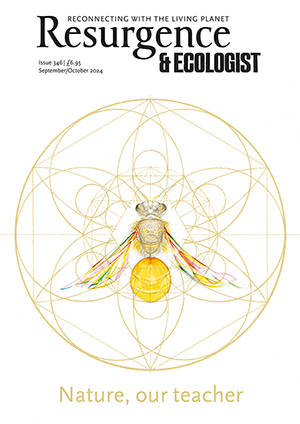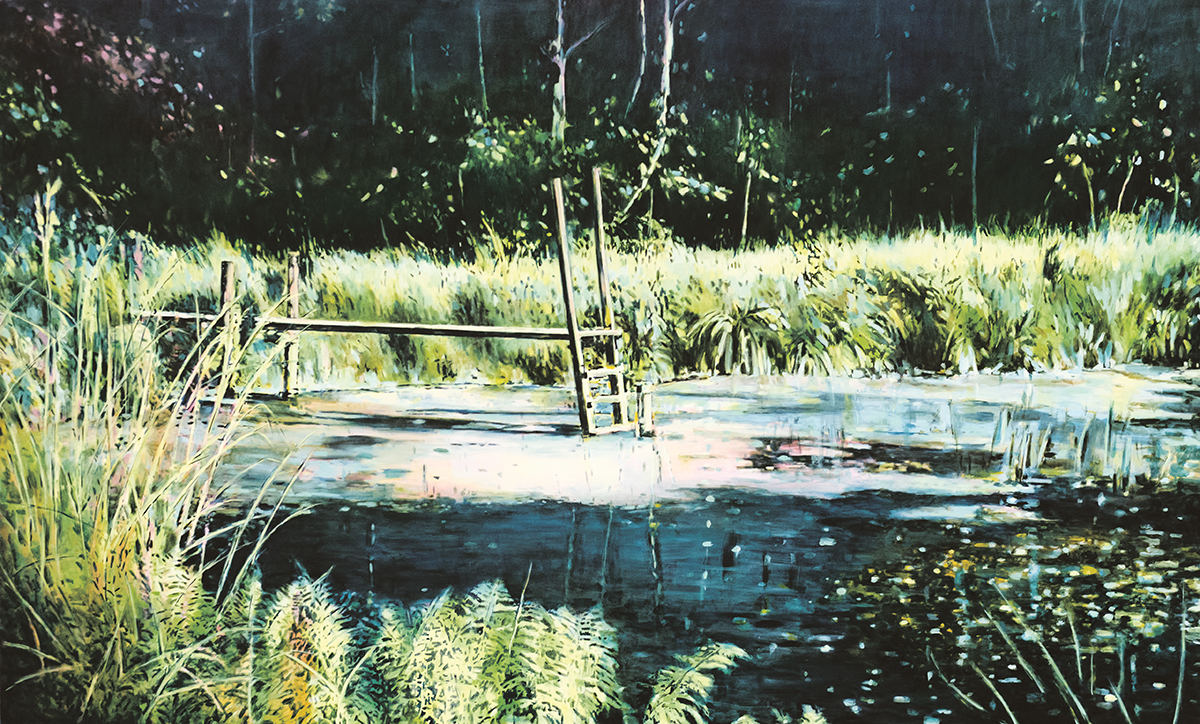“I wondered why it was that places are so much lovelier when one is alone” – Daphne du Maurier, Rebecca
Annette Pugh paints places of solitude: hidden parks, remote lakesides, private gardens and ponds. Defined by lush foliage, decorative patterns, and heightened pink and purple hues, these are idealised and inviting landscapes, either empty of people or featuring only a single female figure. Conveying silence, a sense of mystery emerges from the artist’s picturesque oases.
The locations in Pugh’s images are private, personal, and are deeply embedded in her psyche. They are, on the whole, places she has come across by happenstance that she says represent “serendipitous moments”. They are often fortuitous discoveries on her walks in the UK and have become places that she visits repeatedly. But, she says, “for the viewer it is not important where they are, rather that they hold a familiarity.”
Viewers are also likely to experience familiarity because Pugh riffs on famous paintings and tableaux from art history. ‘The Swing’ (2023), for instance, is a reworking of Jean-Honoré Fragonard’s 18th-century masterpiece of the same name. Pugh explains that she has long admired this painting “for its romantic frilliness and beautiful detailed foliage”, delighting in its “intimacy and sumptuousness”.
However, in her painting she also hints at Nature’s more fragile beauty, as light breaks through the narrow branches, creating fleeting reflections in the watery pool below. An intensity vibrates across the surface of the image. Although on first inspection it may appear quite still, the mark making and colour are constantly shifting, leaving the painting “just on the edge of restlessness”.
Such canvases “speak of happenings, of the people who have been there”, Pugh says. It’s as if Fragonard’s muse has leapt from the swing, leaving it, and the framed realm, behind. Similarly, in ‘The Landing Stage’ (2023), steps from a long wooden platform lead into the water, as if willing a nearby bather to take a plunge in the pool. Speckled mustard yellow, it has a sense of movement, created by the artist’s application of paint. Wild plants, too, seem to part, hinting at human presence.
The artist explains that her paintings “show traces of human intervention, rather than figures themselves. It is as though they might have moved out of shot. These implied but unseen figures could be viewing the scene from my standpoint, across a lake or through the foliage.” Deliberately provoking the question, “What has happened or is about to happen there?” she adds to the filmic qualities of her paintings.
Pugh has long had an interest in film and photography, and where she chooses to include figures, they seem to develop like images in a darkroom. Emerging from a haze of pastel tones in Pugh’s painting ‘In the Pale Blue Light’ (2017) is a thoughtful woman whose luminous dress brings radiance to the rest of the composition, as if containing magical qualities.
Pugh finds these women in archive imagery, photographs at flea markets and family albums, although she then deliberately separates them from their original groups. Transported to the artist’s painted world, the female figures find themselves isolated but centre stage, as if Pugh is reclaiming their long-forgotten stories.
Forefronting her protagonists against evocative backdrops, Pugh’s narratives recall Daphne du Maurier’s gothic tales, in which everything is not as it seems, and, just as in du Maurier’s fiction, which Pugh enjoys reading, the female characters find themselves in places infused with memories, atmosphere and mystery.
There is an episodic quality to her figurative works, which capture what the artist terms “uncertain moments”. In ‘Here Where the Roses Bloom’ (2015), the woman’s expression is inscrutable. Nevertheless, she seems at peace in her natural realm. One shoe sinks into the bed of grass, while her floral dress complements the rose garden, creating a moment of intimacy, as well as a real sense of belonging. For Pugh’s women, there is nothing to fear from Nature, with which they are deeply connected.
In a similar vein, the artist transports her viewers to remote landscapes and gardens, which are enchanting rather than haunting, and places of comfort. Bordered by ferns and tall grass, ‘The Landing Stage’ is, Pugh suggests, concealed from passers-by, but she has chosen to reveal it to her own audience, letting them in on the secret and wrapping them in her aesthetic ideal.
Painted with a powerfully immersive quality, the artist’s landscapes not only pull viewers in, but also centre them in the scene, as if inviting them to climb on the swing, splash in the fountain, sit in the garden, or walk up to the water’s edge. At the same time, Pugh’s compositions provide a space for quiet reflection and still contemplation, giving viewers the opportunity to find solace in their natural silence.
Annette Pugh’s work will be included in The Anomie Review of Contemporary British Painting 3. She is represented by the Bristol-based roving art gallery Gala Fine Art. Instagram @annettepughstudio








